2022 Pivot Shadowcat
Wheel Size: 27.5”
Travel: 140 mm rear / 160 mm front
Frame Material: Carbon Fiber
Build Overview: See Below
Price: $6,199 to $13,599
Size Tested: Medium
Blister’s Measured Weight: 28.8 lb / 13.1 kg
Reviewers:
- 5’10”, 165 lbs / 178 cm, 74.8 kg
- 5’9”, 167 lbs / 175 cm, 75.7 kg
- 5’8”, 155 lbs / 173 cm, 70 kg
Test Location: Crested Butte, Colorado
Test Duration: 3.5 months

Intro
The Shadowcat is a brand-new offering from Pivot that replaces the Mach 5.5 in their lineup, and in a world where seemingly every new bike is a 29er (or a mullet), the Shadowcat is a mid-travel Trail bike that sticks with 27.5’’ wheels at both ends.
Not that we’re complaining. I’ve argued more than once that a lot of people made the jump to 29’’ wheels right at the same time that mountain bike geometry was improving wildly and over-attribute the changes they felt to the bigger wheels over the modern geometry, and that 27.5’’ wheels absolutely still have their place in the world. And it’s not like 29er fans are short on options these days, either. But the wheel size is far from the only thing that’s interesting about the Shadowcat.
We recently got in a Shadowcat for a long-term review, and Blister Members can read our Flash Review of the new Shadowcat for our initial on-trail impressions. Become a Blister Member now to check out this and all of our Flash Reviews, plus get exclusive deals and discounts on gear (including We Are One carbon wheels), and personalized gear recommendations from us.
In the meantime, let’s dig deeper and see what Pivot has come up with.
The Frame
No surprises here, for anyone who’s familiar with Pivot’s recent offerings — the Shadowcat is available in carbon fiber only and features DW-Link suspension with the new vertical shock orientation that Pivot has been moving toward for the last few years. That layout leaves room for two water bottle mounts inside the front triangle (on the downtube and underneath the top tube) plus a third under the downtube. Interestingly, the mount on the top of the downtube offers two different positions for the bottle (via four total bolts, in an overlapping pattern) and Pivot’s Dock Tool multi-tools are available as well.
Pivot offers all the standard features that you’d expect on a modern, high-end frame: the cable routing is internal (and, per usual for Pivot, features provisions for Fox Live Valve suspension), there’s molded rubber protection on the chainstay, seat stay, and downtube, ISCG chain guide tabs are included, and the derailleur hanger is a SRAM UDH. And Pivot’s preferred PF92 bottom bracket standard is here, too.
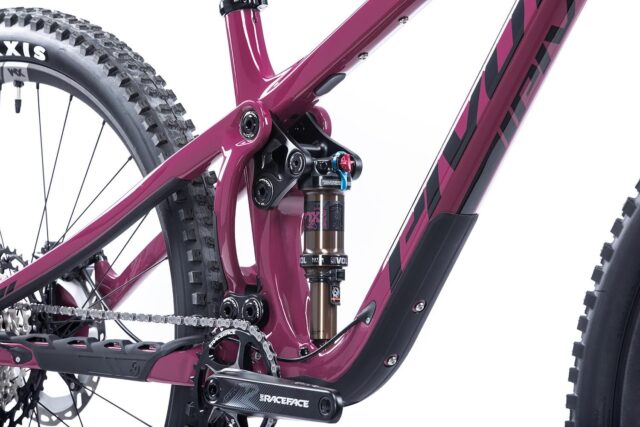
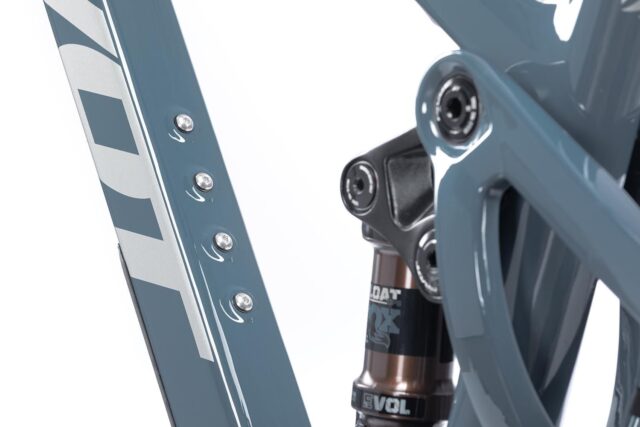
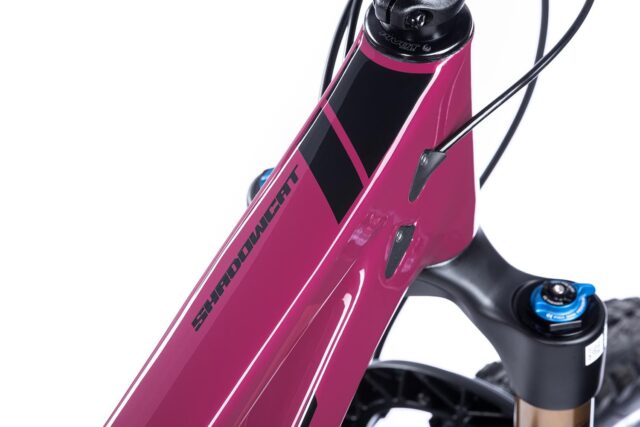
The Builds
Pivot tends to offer a ton of different build options on most of their bikes, and the Shadowcat is no exception. The builds break down into Pivot’s typical Race / Pro / Team hierarchy, with SRAM and Shimano options for each. The full rundown is as follows:

- Fork: Fox 36 Performance
- Shock: Fox Float DPS Performance
- Drivetrain: Shimano SLX, w/ XT rear derailleur
- Crankset: RaceFace Ride
- Brakes: Shimano SLX M7120 4-piston, 180 mm rotors
- Wheels: DT Swiss M1900
- Dropper Post: Fox Transfer Performance Elite (XS: 125 mm; S: 150 mm; M & L: 175 mm)
- Fork: Fox 36 Performance
- Shock: Fox Float DPS Performance
- Drivetrain: SRAM GX w/ X01 rear derailleur
- Crankset: SRAM Descendant 7k
- Brakes: SRAM Guide RE, 180 mm rotors
- Wheels: DT Swiss M1900
- Dropper Post: Fox Transfer Performance Elite (XS: 125 mm; S: 150 mm; M & L: 175 mm)
- Fork: Fox 36 Factory Fit4
- Shock: Fox Float DPS Factory
- Drivetrain: Shimano XT, w/ XTR rear derailleur
- Crankset: RaceFace Æffect R
- Brakes: Shimano XT M8120 4-piston, 180 mm rotors
- Wheels: DT Swiss XM1700
- Reynolds Blacklabel Trail w/ Industry Nine Hydra hubs available for $1,350 upcharge
- Dropper Post: Fox Transfer Factory (XS: 125 mm; S: 150 mm; M & L: 175 mm)
- Fork: Fox 36 Factory Fit4
- Shock: Fox Float DPS Factory
- Drivetrain: SRAM X01
- Crankset: SRAM X01
- Brakes: SRAM G2 RSC, 180 mm rotors
- Wheels: DT Swiss XM1700
- Reynolds Blacklabel Trail w/ Industry Nine Hydra hubs available for $1,350 upcharge
- Dropper Post: Fox Transfer Factory (XS: 125 mm; S: 150 mm; M & L: 175 mm)
- Fork: Fox 36 Factory Live Valve
- Shock: Fox Live Valve Factory
- Drivetrain: Shimano XT, w/ XTR rear derailleur
- Crankset: RaceFace Æffect R
- Brakes: Shimano XT M8120 4-piston, 180 mm rotors
- Wheels: DT Swiss XM1700
- Reynolds Blacklabel Trail w/ Industry Nine Hydra hubs available for $1,350 upcharge
- Dropper Post: Fox Transfer Factory (XS: 125 mm; S: 150 mm; M & L: 175 mm)
- Fork: Fox 36 Factory Fit4
- Shock: Fox Float DPS Factory
- Drivetrain: Shimano XTR
- Crankset: RaceFace Next R
- Brakes: Shimano XTR M9120 4-piston, 180 mm rotors
- Wheels: Reynolds Blacklabel Trail w/ Industry Nine Hydra hubs
- Dropper Post: Fox Transfer Factory (XS: 125 mm; S: 150 mm; M & L: 175 mm)
- Fork: Fox 36 Factory Live Valve
- Shock: Fox Live Valve Factory
- Drivetrain: SRAM X01
- Crankset: SRAM X01
- Brakes: SRAM G2 RSC, 180 mm rotors
- Wheels: DT Swiss XM1700
- Reynolds Blacklabel Trail w/ Industry Nine Hydra hubs available for $1,350 upcharge
- Dropper Post: Fox Transfer Factory (XS: 125 mm; S: 150 mm; M & L: 175 mm)
- Fork: Fox 36 Factory Fit4
- Shock: Fox Float DPS Factory
- Drivetrain: SRAM XX1 AXS
- Crankset: SRAM XX1
- Brakes: SRAM G2 RSC, 180 mm rotors
- Wheels: Reynolds Blacklabel Trail w/ Industry Nine Hydra hubs
- Dropper Post: RockShox Reverb AXS (XS: 125 mm; S–M: 150 mm; L: 170 mm)
- Fork: Fox 36 Factory Live Valve
- Shock: Fox Live Valve Factory
- Drivetrain: Shimano XTR
- Crankset: RaceFace Next R
- Brakes: Shimano XTR M9120 4-piston, 180 mm rotors
- Wheels: Reynolds Blacklabel Trail w/ Industry Nine Hydra hubs
- Dropper Post: Fox Transfer Factory (XS: 125 mm; S: 150 mm; M & L: 175 mm)
- Fork: Fox 36 Factory Live Valve
- Shock: Fox Live Valve Factory
- Drivetrain: SRAM XX1 AXS
- Crankset: SRAM XX1
- Brakes: SRAM G2 RSC, 180 mm rotors
- Wheels: Reynolds Blacklabel Trail w/ Industry Nine Hydra hubs
- Dropper Post: RockShox Reverb AXS (XS: 125 mm; S–M: 150 mm; L: 170 mm)
Some Questions / Things We’re Curious About
(1) The Shadowcat offers a somewhat unusual combination of traits — it’s a lightweight mid-travel Trail bike that seems to be quite focused on being efficient and snappy, but packages that with 27.5’’ wheels and a bit more suspension travel than most bikes that place such an emphasis on efficiency. So how does that add up on the trail?
(2) And for folks who do want a very lively, efficient ride, who will be better off on a shorter-travel 29er, and who will get along best with the added squish and smaller wheels of the Shadowcat?
Flash Review
Blister Members can read our Flash Review of the new Shadowcat for our initial on-trail impressions. Become a Blister Member now to check out this and all of our Flash Reviews, plus get exclusive deals and discounts on gear like We Are One carbon wheels, and personalized gear recommendations from us.
Bottom Line (For Now)
Pivot’s new Shadowcat is an intriguing new bike that offers a combination of features that we don’t often see in 2022 — but that it’s easy to imagine being very appealing for certain riders. We’ve got a Shadowcat in for long-term testing and have a full review in the pipeline.
FULL REVIEW
Intro
Over the past several months, the Pivot Shadowcat has seen time under more reviewers than most of the test bikes that come through Blister HQ. And at a time when most new releases are a 29er (or a mullet), the full 27.5” wheeled Shadowcat feels like a bit of a mythical creature on the trails these days. Let’s dive into how it was received by a diverse group of reviewers:
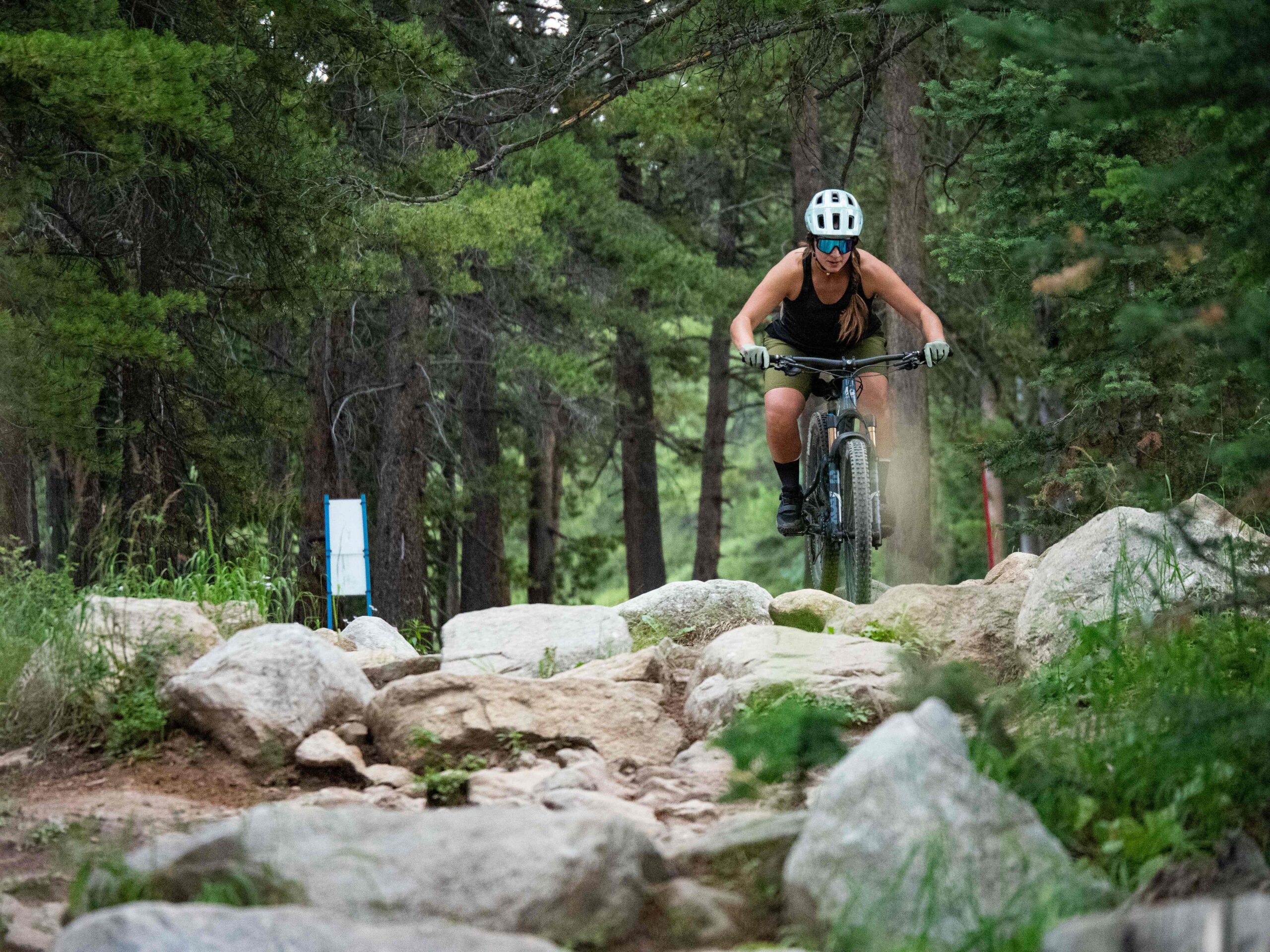
Fit and Sizing
Eric Freson: (5’10”, 165 lbs / 178 cm, 74.8 kg): We tested a size Medium Shadowcat. Since 2019, I have oscillated between a number of Medium and Large Pivot frames, and have found that I can happily live with either. In this instance, the size Medium was a great fit for how and where I primarily rode it, and it was also nice to be able to make comparisons against the Mach 5.5 I had previously reviewed (also a Medium). The Shadowcat’s 460 mm reach is right in the ballpark of my own personal “ideal,” and with a 614 mm stack height, 76° seat tube, and 1206 mm wheelbase, everything quickly felt familiar after throwing a leg over it, even after spending the summer on some very large and long-travel bikes. All that is to say people are adaptable, I’m pretty average as far as proportions go, and Pivot has been building refined frames for a long time.
Kara Williard (5’9”, 167 lbs / 175 cm, 75.7 kg): Pretty quickly, it became apparent that the Medium was the right size for me on the Shadowcat. I haven’t had time on other Pivot frames, but as someone with a slightly longer torso than average for my height, the 460 mm reach in the Medium frame provided plenty of room, leading to the feeling of sustained comfort on long climbs, and I didn’t have to shift around too much on descents in order to feel centered or stable on the bike.
It seems pretty obvious that a Large frame would be quite a stretch for me on the Shadowcat. Across all applications, the Medium felt comfortable and spacious in the right way.
Luke Koppa (5’8”, 155 lbs / 173 cm, 70 kg): Out of us three (and 5’10” Dylan Wood, who also rode the Shadowcat), I’m the one most squarely slotted into the recommended range for our size Medium test bike, and that felt totally accurate on trail. It was a very comfortable, intuitive fit overall; not too short, not excessively long, and at home in a wide range of scenarios. If I was primarily pedaling up super steep fire roads, I might prefer a slightly steeper seat tube angle, but the upside of the Shadowcat’s “steep but not wildly so” seat tube angle is that it doesn’t feel awkward when pedaling in the saddle on flatter or rolling sections, as can be the case with angles pushing closer to 80°. The front end of this bike did feel a bit lower than I was used to when I first got on it, but I pretty quickly got used to that and it never created an issue on steeper descents.
Climbing
Eric: I’ve been a big fan of a lot of DW-Link bikes over the years, and climbing is a big part of that. If you have been reading our MTB reviews for any amount of time, you know this about me. But bottom line: for the relatively smooth, steep, and high-vert climbs in the Gunnison Valley, DW-link works great for me and my preferences. More than absolute traction over slick roots or rocks, I find that the efficiency and power transfer of the DW-link bikes I’ve tried is a great fit for what I ride. It’s no different with the Shadowcat. Once you quickly set up your sag with Pivot/Fox’s easy sag indicator on the DPS shock and get the rebound damping in the right ballpark, you can get going. While some general suspension designs can vary a ton between models, DW-Link seems to be one platform with a notable consistency between the bikes that employ it. Therefore, the geo, weight, and wheel size are what stood out most during my time aboard the Shadowcat.
Starting with geo, the 627 mm effective top tube and 460 mm reach are both relatively large numbers for a size Medium 27.5” Trail bike. This meant that when seated and spinning, the Shadowcat felt comfortable (for me, as someone who’s often deciding between Medium and Large frames) and relaxed thanks to the roomy reach. But with a long-ish front-center by today’s standards, it was also easy to stand out of the saddle and attack without immediately getting way over the front wheel. There’s room to work with here, which is important for creating explosive speed, which is important for making a bike feel playful, which is important for fun. It’s fun.
The Shadowcat’s weight … is noticeably light. At a time when the pendulum is generally going in the other direction, the Shadowcat stands out in this regard. The frame is light. The build is light. The Dissector tires are fast rolling and spin up quickly. It *feels* and rides like a light bike thanks to the sum of its parts. And the wheel size … while I don’t know the actual difference between the weight of the same wheel / tire setups in 29 / 27.5 flavors, I do know that the felt difference was real. The 27.5 wheels spin up faster, and the contact patch on the trail is smaller. It all adds up to something that feels quick and sharp.
So in sum, I found climbing aboard the Shadowcat adaptable. If you sit and spin, it’s comfortable, the suspension is efficient, and you’re going to feel efficient. If you want energetic, lively, and “fun” to be adjectives you think of when climbing, just get out of the saddle and attack. The suspension design, long top tube, lightweight build, and smaller wheel size all mean that the Shadowcat is quick to build trail speed, easy to shift your weight aboard, and rewards powerful bursts of energy. Attack that technical feature, pivot around that steep switchback, or stand up and blow your lungs out, it’s a lot of fun.
Kara: Unlike Eric, I did not have any previous time on a DW-Link bike, so this was a brand-new experience. For that reason alone, it was pretty easy to go in with a clear head, having no idea what to expect.
I pretty quickly discovered that the Shadowcat feels impressively efficient and swift on climbs. For reference, I rode quite a few sustained climbs (over 3,000’ gain) on it, all of which were here in the Gunnison Valley, which offers everything from long, gradual double track to punchy rocky segments and mellow but sustained singletrack. Across all of these applications, I found the Shadowcat to feel efficient, and it maintains a lot of traction even on the looser climbs. The overall weight of the Shadowcat, and the fit I experienced on the bike, made it easy to pull up on rocks and other features while ascending.
One of my weaker skills on a bike is attacking climbs out of the saddle, but interestingly, I found the Shadowcat to be an intuitive and comfortable bike on which to practice this. Even when shifting forward and coming out of the saddle, I was surprised by how locked in the rear tire felt, and it was easy to achieve a natural, balanced position without feeling nearly as awkward as usual, or having to push as far forward with my torso while working on climbing out of the saddle.
Of a couple of bikes I spent time on this summer, the Shadowcat was notably the most efficient and created the least amount of pedal bob. This translated to a whole lot less reliance on locking out the rear shock, especially on the shorter climbs. The fact that it wasn’t glaringly obvious when the shock wasn’t locked out on climbs is something I considered a plus.
Overall, the Shadowcat was a bike that I would choose regardless of how much climbing I was going to be doing, and for someone who likes to climb and prioritizes rides with pretty long ascents, the Shadowcat was more than capable. I found that it felt stiffer, more comfortable, and easier to propel over features than the 2019 Specialized Stumpjumper 29er that I have a few too many miles on, and as a result, it quickly became my favorite bike for getting out on some longer days.
Luke: Yeah, this bike climbs really well — especially considering that a lot of 140mm-travel Trail bikes these days resemble short-stroked Enduro bikes. The Shadowcat is not only noticeably light and very efficient under power, but it also encourages (and rewards) a more aggressive approach on the ascent than most bikes in its class.
As noted earlier, ultra-steep climbs were the only instances where I felt I could’ve benefited from a slightly steeper seat tube angle, but this is a tradeoff that comes with the bonus of feeling comfortable pedaling on flat roads and having room to move around for out-of-the-saddle efforts.
The Shadowcat definitely isn’t the most tractor-like when it comes to rear-wheel traction while putting the power down on loose surfaces, but it felt average, if not slightly above average in that regard when compared to other bikes that feel similarly efficient / firm in terms of lack of pedal bob.

Descending
Eric: I found the Shadowcat to be exactly what others have mentioned it to be in our Flash Review. Fun, agile, and playful. It excels on flowy and feature-rich trails that encourage multiple line choices and play. The short chainstays, longish reach, and average wheelbase came together to create a personality that was very capable, but agile.
The 27.5’’ wheels and the bike’s ability to easily transfer weight from front to back tire meant that the Shadowcat is easy to manipulate, transfer, and adjust your trail position without needing to “muscle” the bike into cooperation. Something I found myself doing during my time with the Shadowcat was running my suspension a touch softer and more progressive to capitalize on the bike’s ability to move around the trail. This wasn’t a bike that inspired me to straighten out the trail. I’d find myself looking for features and opportunities to be engaged and change the orientation of my momentum.
The Shadowcat reminded me a lot of the Mach 5.5 it’s replacing — in that it thrives on trails with frequent elevation, pitch, and speed changes. Its head angle and wheelbase afford you a satisfying blend of speed, handling, and stability, which manifests as a feeling of agility. Whereas the Mach 5.5 manifested this more as a feeling of precision. I don’t know for sure, but I suspect that the Mach 5.5 frame was stiffer. I do know that the 2.6 DHF tires and Reynolds carbon rims the Mach 5.5 used felt more precise (stiffer) than the Dissectors and DT Swiss XM1700 wheels on our Shadowcat. I wouldn’t call the Shadowcat flexy as a package, but it is compliant, not harsh or stiff.
Trail bikes with a bigger fork up front are some of my favorites to ride because you get the angles and travel up front to handle speed, and the mid-travel suspension platform out back to keep things in check (while always being ready to respond to a pedal stroke, leg pump, or bunny hop). But something that really surprised and impressed me about the Shadowcat was how sensitive the rear end was to small trail noise. The trail “feel” and traction was fantastic. The Shawdowcat’s travel doesn’t feel as deep or progressive as the Switchblade or Firebird, but the tradeoff is that, while it might not feel as composed in large shock compression situations, it does feel more active and more accessible more of the time. Overall, I found it to be an extremely capable bike everywhere (as most modern bikes are), but, I found it to be more biased towards fun than all-out speed.
Kara: I might be overstating here, but I will reiterate what has been mentioned more than once. It has been said in our several Flash Reviews, and Eric just said it again: the Shadowcat is agile, intuitive, and versatile across a multitude of descents and trail conditions. I was continually impressed by the well-balanced mix of stability to agility, even when playing around with some different riding styles and trail conditions. When cornering, the Shadowcat does a good job of easily navigating tight sections while still providing good traction. It also is a bike that was pretty intuitive to dip a little tighter into corners or make small, precise movements with.
The Shadowcat felt most at home on flowier, smoother terrain, and I especially loved building speed on it through lots of dips and “whoops;” it was also easy to get into the air, as a result of its mixture of agility and overall low weight.
However, the Shadowcat was also quite comfortable in techier, more exacting terrain. The Shadowcat is a bike that felt apt for progression. In part because of how intuitive it is, and also because of its versatility in terms of riding style; it could handle some bigger features and higher speeds, while still feeling nimble at more moderate paces and on mellower terrain.
Luke: As I noted in our Flash Review, it’s really hard to refrain from using the same words when describing this bike. But hey, we clearly don’t have a word limit here at Blister, so might as well…
Yeah, this bike is really quick, nimble, playful, and really any other word you can use to describe a two-wheeled machine that feels easy to pick up, move around, and change directions with minimal rider effort.
That was clearly the standout trait of the Shadowcat for me. However, what’s maybe more impressive is that, given how much the Shadowcat stands out in that regard, it still feels like a pretty cohesive, intuitive, and versatile overall design. It’s certainly not the most stable, composed bike in its travel class when riding fast through chunky sections of trail, but it also never gave me any scary surprises in those scenarios. Especially in a world where a lot of brands are trying to eke out all the high-speed stability they can from a given amount of travel, the Shadowcat was a refreshing take on a 140mm-travel Trail bike — without going so far that it feels really niche in its ideal application.
The Shadowcat really seemed like the perfect tool for the job when I was riding a mixture of smooth flow trails and moderately technical ones. That’s where a shorter-travel bike can make you regret your lack of squish in the rougher parts, but a longer-travel one can start to feel boring / excessive on the smoother ones. Or put in a different way, if my riding over the course of the season comprised that sort of 50/50 mix, the Shadowcat would be pretty ideal. Bikes that are more efficient might be better for the mellower lines, and longer-travel ones certainly let me get away with sloppier technique and higher speeds in the rougher sections, but the Shadowcat does an admirable job of covering both ends. And it does that while still being considerably more agile and engaging than many of its ~140mm-travel competitors.
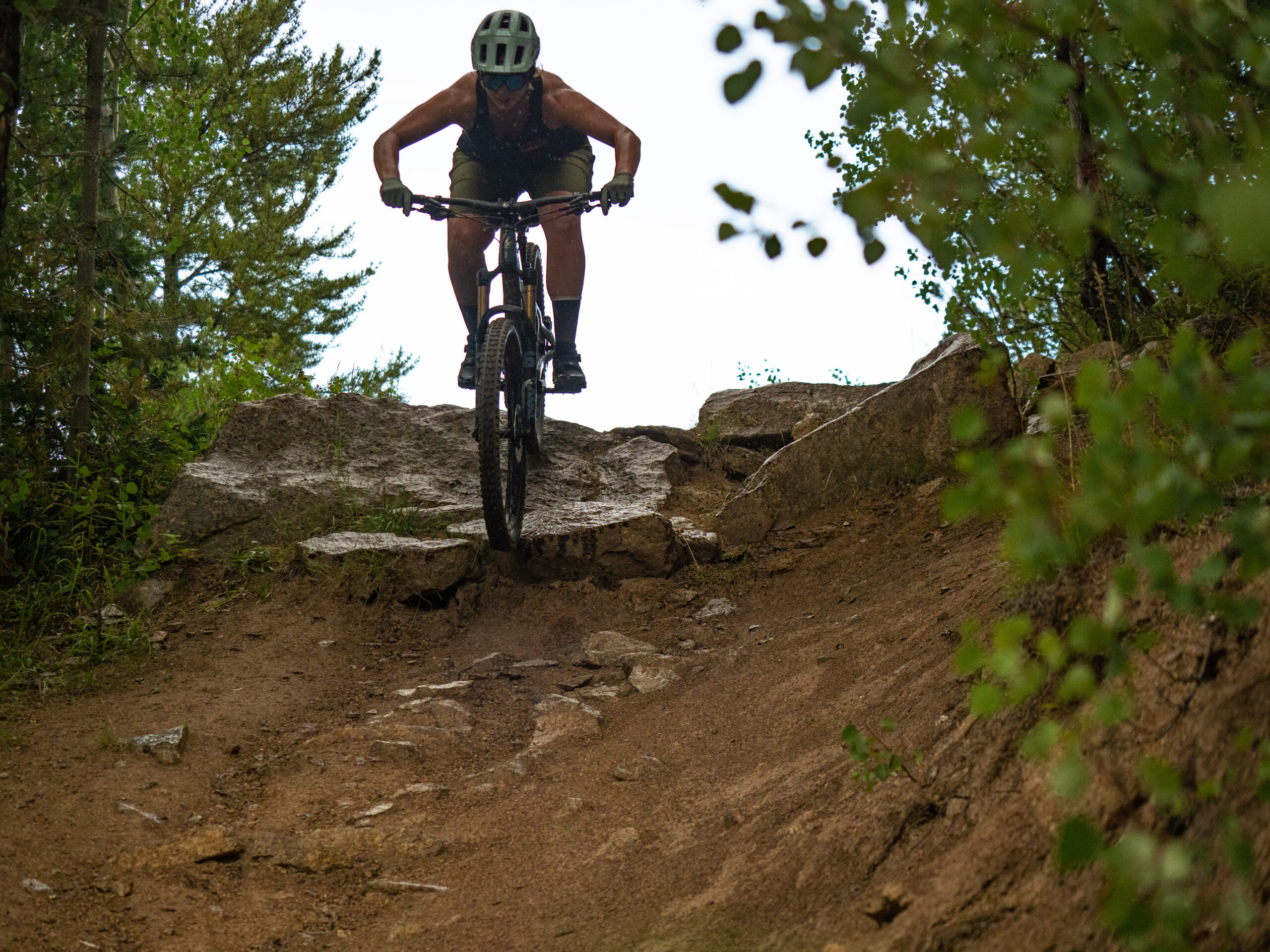
The Build
Eric: Have I ever much to say about Pivot builds? No, not really (aside from cost). These are high spec’d bikes, and the builds are simply varying levels of “really nice.” It’s the same with the Shadowcat’s Pro XT/XTR build. But there are a few things that stood out to me.
It’s been a minute since I have been on a Fox fork with a Fit4 damper. I was curious and interested to come back to it. Historically, I have found the Fit4 damper to feel a bit less sensitive than the Grip2 dampers, especially early in its travel, but here, running my fork a bit softer than I might normally in an effort to maximize traction and pop, the Fit4 damper felt great. If I was running more air and more compression damping as I would normally, I’d maintain that the Fit4 has a high ceiling of performance, but is a bit less sensitive than other Fox options.
The rise, sweep, and most subjectively, flex, of Pivot’s bars really work well for me. It’s still the same here. But I love that the Shadowcat is spec’d with a carbon bar that has a flex profile that I really jive with. Similarly, I continue to enjoy Shimano’s XT brakes. The lever feel, lack of flex in the lever / lever body, and strong initial power / bite all help them to feel sharp and precise.
Finally, I think the Maxxis Dissector tire is a perfect spec for a bike like the Shadowcat. They are relatively lightweight, have good rolling speed, and have strong cornering bite relative to their knob height and casing. The Dissector does not impress in longevity, but for a bike that rewards getting up to speed quickly, explosive moves, slashing, slicing, and all the rest of the playful adjectives, it’s a great mix of tire characteristics that align with what I feel is the bike’s intended use. Yes, you can absolutely throw some DHFs on (or anything similar) and the Shadowcat will pick up some straight-line speed and stability, but I think you’d lose some of the agility which has made this bike so enjoyable to ride and has helped it to stand out from the crowd relative to so many Trail and Enduro bikes which are focused on being “fast” these days.
Kara: The build? Well, the build spoiled me, and took what was already a really lightweight frame design and complemented it nicely. As someone who hasn’t been on many bikes with higher-end specs, I quickly grew a liking for the Pro XT/XTR grouping. Of course, the Shadowcat is offered in builds that soar well above the Pro XT/XTR builds, but for my needs, and when comparing it to what I have been spending a lot of time on, this build felt more than adequate, and in fact, quite impressive, lightweight, and precise.
What stood out most was the XT brakes, which are responsive and continue to impress me even when being tested through excessive braking (as I tend to do). The XTR derailleur also felt quick and precise, even when testing under load or with little forethought when rolling into punchy or unexpected climbs.
It took a bit of finetuning for me to figure out the best settings with the Fox 36 Factory Fit4, mostly just because I am most accustomed to Rockshox forks and it took a bit of finetuning to feel comfortable with all the settings.
As mentioned in the Flash Review, I found that the Shadowcat’s shock can be pushed on repeated hits through rock gardens and drops, and it maintains a smooth ride overall. Throughout my time on the Shadowcat, I found that running the fork a bit softer than the recommended spring rate felt best for me based on my preferences. I prefer a supple and spongier fork, and I rarely encounter compressions and drops harsh enough where more maximum support is needed. Running it like this, I found the fork to feel smooth and comfortable even in the rockiest of terrain.
Luke: Yeah, the good news is, given that Pivot doesn’t offer many lower-budget builds, their relatively high-end builds hit the right marks. Overall, there aren’t any things I’d feel immediately inclined to change with the Pro XT/XTR build of the Shadowcat.
I was initially very curious as to why Pivot didn’t decide to offer some “Enduro” builds for the Shadowcat, like they do with their Trail 429, where faster-rolling and more efficient tires and suspension are swapped for more descending-oriented alternatives. I personally would be curious to try the Shadowcat with a Grip2-equipped Fox 36 fork and a Float X shock. But then I took a quick look at the Pivot Switchblade, and given how similar the two Pivot bikes are on paper, it seems more reasonable that Pivot is deliberately positioning the Shadowcat as a lighter, more playful, more nimble, more efficient alternative to its similarly squishy but fully 29” wheeled counterpart.
Overall, none of the Pro XT/XTR Shadowcat’s components felt like they were actually holding me back, which is what I’d hope for from a build of this price. If I owned this bike, I’d probably replace the front tire with something a bit more aggressive whenever the front Dissector wore down, and I’d consider going with a more descending-oriented shock and/or fork down the line, but I was really impressed by how well the components balanced downhill and uphill performance.
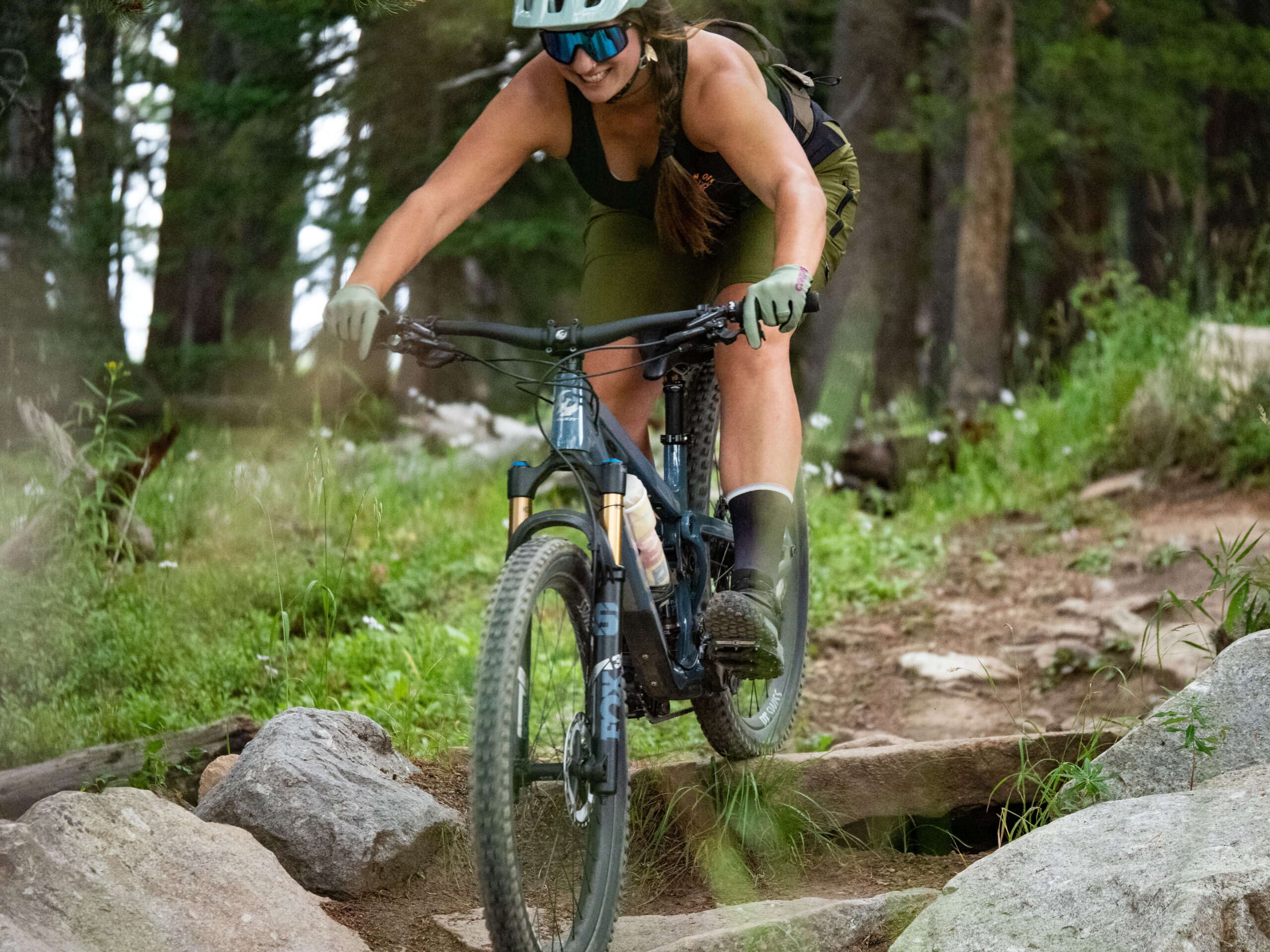
Comparisons
If you look at these two bikes from the same manufacturer, on paper, they look really similar. And overall, they are. They’re both efficient, fairly light bikes that prioritize uphill performance and overall agility over maximum composure when riding fast down really rough descents (at least compared to the modern ~140mm-travel class).
That said, between its wheel size and builds, the Switchblade does a bit better at handling the latter, at the slight cost of the former. The Shadowcat feels a bit more eager and efficient on the up, whereas the Switchblade feels a touch more planted and better at carrying speed on the down.
Mostly though, the builds will be a big deciding factor — the Switchblade is available with more descending-oriented builds that do feel more composed in repeated big hits, whereas the Switchblade feels quicker on sections that require more frequent, more rapid changes of direction. Both are really versatile; just pick the one that better suits your preferences.
Similar to the Switchblade, these two share a lot in common. It’s just a role reversal, relative to the previous comparison.
The Trail 429 feels a touch more efficient on the pedals and more rewarding of aggressive outputs on the ascent, whereas the Shadowcat leaves a bit more room for error when bouncing down chunky descents. The Trail 429’s “Enduro” builds make this an even more challenging comparison, but the more you care about uphill efficiency and the less you find yourself barreling down rough descents, the more we’d steer you toward the Trail 429. If you do frequently encounter bumpy sections of trail, then the Shadowcat could be the perfect in-between option if deciding between something like the Trail 429 and a longer-travel Trail or Enduro bike.
Despite sharing fairly similar travel numbers and geo, the Spectral fills a very different role in the “Trail bike” category. The Spectral is far more planted, stable, and composed in rough sections than the Shadowcat. On the flip side, the Shadowcat makes it a whole lot easier to change directions in tight spots, it’s more efficient on the pedals, and overall feels like a shorter-travel bike. The Spectral doesn’t go quite as far into the Enduro category as the next bike, but the Shadowcat is still a whole lot more engaging on non-gnarly trails.
The Meta TR 29 feels like a shorter-travel Enduro bike. The Shadowcat feels like a lively, efficient, and nimble Trail bike. The Meta TR 29 makes sense if you frequently take your Trail bike into “Enduro” or “DH” trails and don’t care a whole lot about how you get to the top of them, whereas the Shadowcat is for those who will maybe hit those trails a few times, but who frequent lines that are more in the middle of the bell curve of sketchiness, and who still care about getting to the top in a somewhat short amount of time.
The Meta TR 29 is considerably more stable, composed, and calm when riding fast through fast, steep, chunky trails; the Shadowcat feels a whole lot more agile when navigating tight turns and/or pumping and jumping through smooth trails.
Who’s It For?
Eric: The Shadowcat is for anyone who is wanting an up-to-date and dedicated 27.5’’ Trail bike. This isn’t a 27.5’’ shreddy park bike to beat on, and this isn’t a 27.5’’ bike because you’re short but want something awesome (though Pivot makes sizes so short people can have a great fitting bike). This is a Trail bike for trail riders who like mountain bikes, like having fun, take their activity and gear investments seriously, and want a set of attributes that align more with words like “snappy and agile” than “calm and stable”.
Kara: The Shadowcat feels like a 1-bike quiver for those who want a well-rounded Trail bike and are pleased by the idea of a 27.5” bike. For someone who prioritizes lightweight bikes with equally capable and well-rounded uphill to downhill capabilities, I think the Shadowcat shines. The Shadowcat also makes a lot of sense for people who are not only needing a bike that can do a lot of things really well but are also prioritizing the idea of progressing on a bike. While the builds of the Shadowcat aren’t necessarily the most economical, for someone who has an affinity for excellent components, and lightweight bikes, matched with good versatility from a single bike, the Shadowcat makes a whole lot of sense.
Luke: While the Shadowcat’s full 27.5” wheel pairing was a big factor in my mind before trying it, that became an afterthought following a few rides.
Rather, I think the Shadowcat makes a ton of sense for those looking into a 1-bike quiver and who ride a pretty equal mix of smooth and rough trails. It’s a great time to be a mountain biker, in that there are so many good bikes out there that do certain things well. And there are also a lot that do a lot of things well.
What makes the Shadowcat stand out is that it manages to be more agile in tight spots, low speeds, and smooth trails than most of its direct competitors, while still being predictable and adaptable when you opt to push it a bit out of its comfort zone, on steeper, faster, and rougher trails.
There are shorter-travel bikes that are (a bit) better on the up, and longer (or similar) travel bikes that are easier to commandeer down rough trails. But the Shadowcat manages to be distinctly agile, maneuverable, and playful when those things are pros, while still being adaptable when bikes that share those traits start to really fall short (e.g., rough, fast, steep trails).
Bottom Line
Eric: #Maketrailsfunagain. Said in jest, but really, the Shadowcat feels like a love letter to having fun on a bike. It’s quick, agile, and energetic — if you’re someone who is as focused on smiles as the lap timer, the Shadowcat delivers. If you’re a fan of 27.5’’ wheels, over-forked Trail bikes, lighter-weight builds, and/or generalist geometry, the Shadowcat is well-positioned for you. It’s great to see a brand offering an up-to-date and modernized option for riders who may have fallen in love with mountain biking when the landscape looked a bit different than it does today, and who hold some nostalgia for smaller wheel sizes, lighter bikes, and a time when every ride felt like a bit more of an adventure.
Kara: The intuitive nature of the Shadowcat made it easy for me to want to dip a little deeper into the corners, take a little more speed into a jump, or just look at the trail with a new perspective. While there are plenty of bikes that are more specific or purpose-built out there, the Shadowcat provides some good, general versatility.
Luke: I’ll echo Eric — some bikes these days, even those in this “moderate” travel class, feel like they only want to smash down things in a straight line. The Shadowcat can do that (albeit, requiring a bit more attention to line choice than those other bikes), but it really stands out in its ability to make all sorts of trails engaging and … fun.

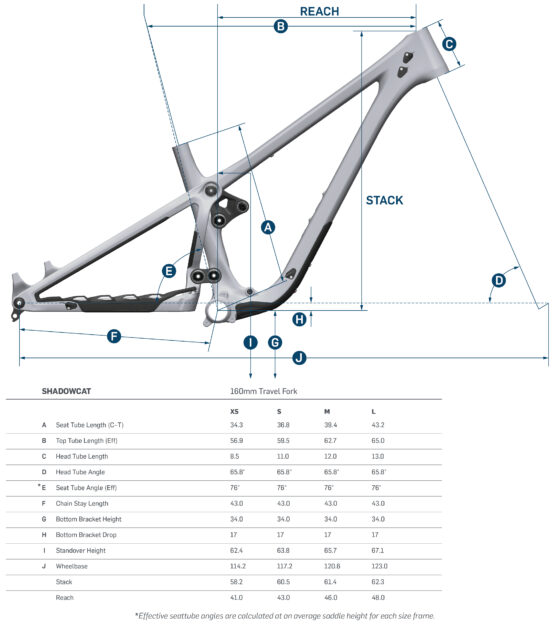
Looks a lot like my Devinci Troy. Should be a fun bike
Looks great. I’m a 29er guy, but this one looks really fun.
But the big news flash is that Chris C has finally decided he doesn’t want to die on the hill of 157 rear ends.
Still having a hard time believing I read that right! ;-)
First real rockgarden would make you want your 29 back :) Or at least in the front.
To the contrary, the rock garden will disappear under this bike !
I wonder how this compares say to my Turner Burner with a 160mm 36 on the front, lighter obviously slightly shorter chainstays and a little shorter wheelbase but not too far off altogether.